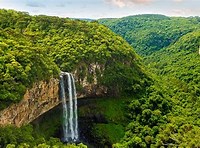By: Alora Peters, Staff Writer
Last month saw the arrival of a massive Saharan dust cloud that blanketed Florida and much of the area surrounding the Gulf of Mexico, including parts of Texas and Louisiana. A second, smaller wave of Saharan dust was projected to remain in the area through early July, reported The Washington Post.
“They’re not a new phenomenon,” said Dr. Christopher Miller, a professor of Ecology and Biology at Saint Leo University. “They’ve probably been around for centuries, so this is not like some sort of zombie apocalypse or pandemic we’ve never seen.”
Part of the reason the Saharan dust clouds have gained increasing coverage, Miller speculates, is due to advancements in technology. Satellite images and photographs from space can be used to track and document the movement of the dust clouds in ways that would have been previously undreamt of.
“The dust storms are formerly known as the Saharan Air Layer,” said Miller. “They form in a classic inversion, which is when warm or relatively hot air rises and puts a cap on a cooler, denser mass of air near the surface—in this case, over the Atlantic Ocean.” It is in these warmer pocket of air—the inversions—that the dust travels.

The continued growth of the Amazon Rainforest is one benefit of the annual Saharan sand clouds. (Global Environment Facility).
“Due to prevailing winds called the Northeast Trade Winds… the dust is transported across the Atlantic into the Caribbean,” said Miller. “The Trade Winds blow from Northeast to the Southwest, all across the globe—including across North Africa.”
Though traveling Saharan dust clouds are an annual and perfectly normal phenomenon, the wave that arrived this summer was “arguably one of the most… extreme events on record,” the Washington Post noted. The cloud was even given the nickname “Godzilla,” due to its “unusually large size,” wrote USA Today.
The arrival of the Saharan dust clouds meant the arrival of poor atmospheric conditions, reduced air quality and visibility, and a moderately polluted atmosphere, according to The Washington Post.
However, as USA Today pointed out, the Saharan dust cloud also resulted in some truly spectacular sunsets and sunrises, due to dust’s ability to refract sunlight.

The “Godzilla” sand cloud resulted in air pollution and reduced visibility in parts of the southern United States, the Caribbean, and the Gulf of Mexico. (The Spectator)
But picturesque views were not the only benefits to this annual, natural phenomenon.
“Contrary to popular belief, Saharan dust… [does]more than create runny noses,” wrote Attish Kanhai, Research Officer at the Institute of Marine Affairs.
The annual Saharan dust clouds actually perform a crucial role in the natural cycle of the Amazon Rainforest. According to Kanhai, about 27 million tons of Saharan dust fall annually upon this South American forest. The Saharan dust supplies an important nutrient—phosphorous—that assists with vegetative growth. Because the soil of the Amazon Rainforest loses around 90% of its phosphorous content due to rainfall, the Saharan dusts clouds help resupply this vital mineral and effectively defend the “biodiversity of the Amazon [from]adverse effects.”
The Institute of Marine Affairs points towards other important benefits that result from the Saharan dust clouds. Along with phosphorus, the dust deposits are rich in iron, a mineral consumed by phytoplankton—photosynthetic, aquatic creatures that are “responsible for [the]production of half of the world’s oxygen and uptake of half of the carbon dioxide on the planet.”

Saharan sand clouds can be visible from space, according to the Institute for Marine Affairs. (Fast Company)
However, this “fertilizer… is not necessarily a good thing,” said Miller. The phosphorus that drops over the Caribbean and the Atlantic also serves as a “fertilizer for plant and algae growth, including some not-so-pleasant organisms like Red Tide.”
On the other hand, the Institute for Marine Affairs noted that Saharan dust clouds “[play]a key role in the suppression of hurricane formation in the Atlantic Ocean.” Accompanying elements of the Saharan clouds—such as dry air, vertical wind shear, and the dust itself—can “hamper the development of storms… and formation of clouds.”
“[This] is why we’re not seeing many storms form right now,” said Miller. “It’s certainly hot enough to create a hurricane, but the weather pattern from the Saharan Air Layer prevents storms from being created.”
In summary, the environmental effects of the Saharan dust clouds will be felt long after this natural event has come and gone.




